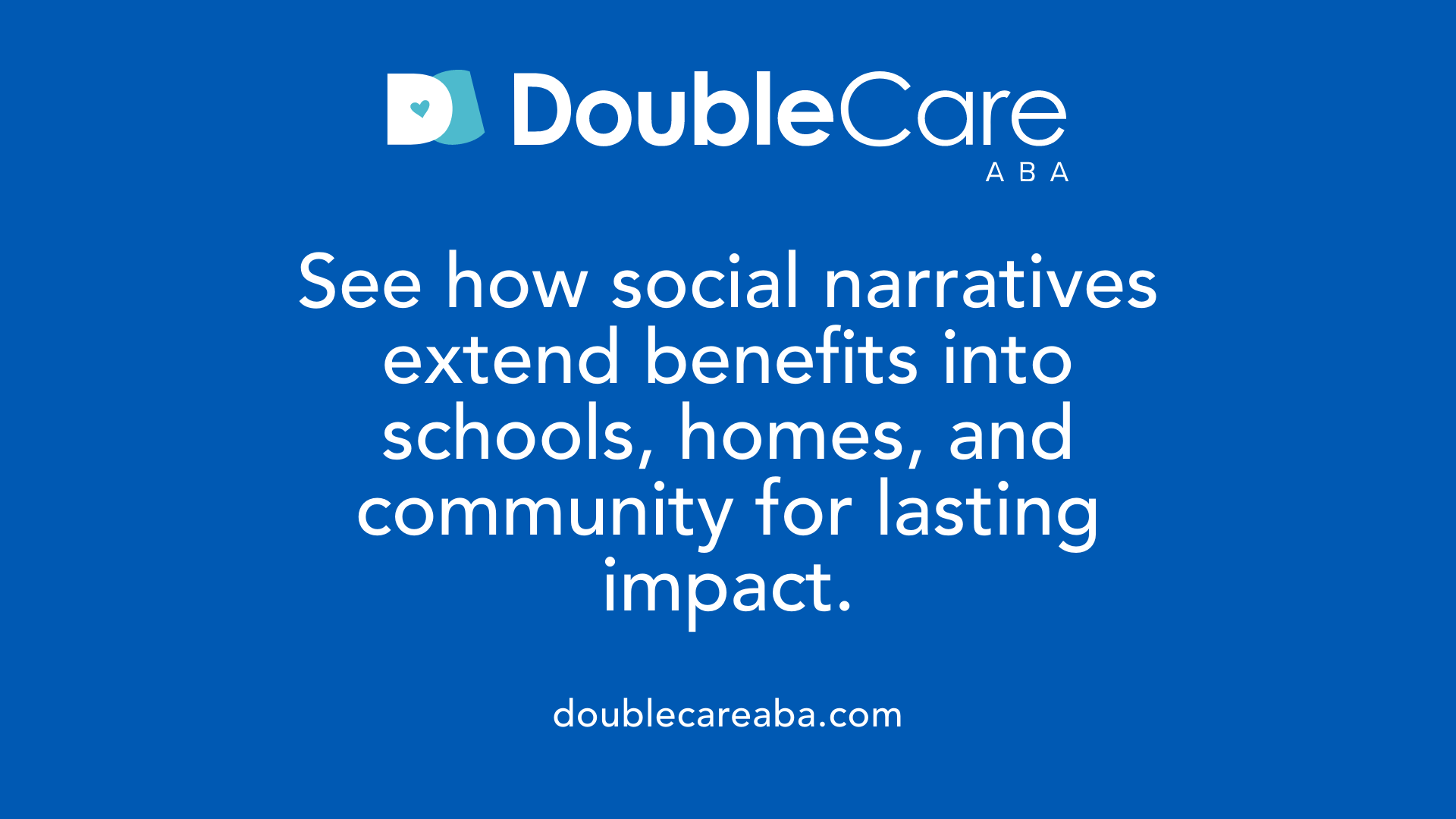Using Social Narratives to Teach New Skills
Harnessing the Power of Social Narratives in Autism Therapy

Bridging Communication Gaps with Social Narratives
Social narratives, often called social stories, are powerful tools designed to help individuals with autism spectrum disorder (ASD) understand and navigate social situations. By providing clear, personalized explanations of expected behaviors and social cues, these narratives support learning new skills and improving social engagement. Integrated within therapeutic approaches like Applied Behavior Analysis (ABA), social narratives leverage visual supports and tailored language to foster independence and confidence in various settings, from classrooms to homes and communities.
What Are Social Narratives and How Do They Support Skill Acquisition?

What are social narratives?
Social narratives are short, written stories designed to help individuals, especially those with autism spectrum disorder (ASD), understand social situations and appropriate behaviors. These narratives use clear, concrete language tailored to the individual's vocabulary and comprehension level. Often, they include visual supports such as pictures, symbols, or illustrations to enhance understanding.
Purpose of social narratives in ASD
The main goal of social narratives is to support skill acquisition in social understanding and interaction. They assist individuals with ASD by explaining social norms and expectations, thus reducing anxiety and promoting positive social engagement. Social narratives can address specific behaviors like hitting or yelling and help prepare individuals for new or challenging social situations.
Structure and components of social narratives
Typically, a social narrative includes several sentence types:
- Introductory sentence: Sets the context for the situation.
- Descriptive sentences: Explain details about the situation and feelings involved.
- Perspective sentences: Offer insight into others' thoughts or emotions.
- Directive sentences: Guide the individual on what behaviors are appropriate.
- Affirmative sentences: Reinforce positive outcomes from following the narrative.
This structured approach helps clarify expectations and promotes appropriate social responses.
Incorporation of visual supports and personalized language
Visual aids like pictures from tools such as Boardmaker or custom images support visual learners, making abstract social rules more concrete. The narratives are personalized to match the individual's comprehension and vocabulary, ensuring relevance and increasing effectiveness.
Types of behaviors and situations addressed
Social narratives can target a range of behaviors including reducing disruptive actions (e.g., aggression, high-pitched vocalizations) and promoting skills like greetings, requesting, emotional recognition, eye contact, and social engagement. They are also used to prepare individuals for transitions, new routines, or community participation.
The Psychological Foundations of Social Narratives in Autism Intervention

What Theoretical Frameworks Underlie Social Narratives?
Social narratives are grounded in several psychological theories that explain the social and cognitive challenges experienced by individuals with autism spectrum disorder (ASD). One pivotal framework is the theory of mind, which relates to difficulties in recognizing and interpreting others' emotions and intentions. This cognitive impairment often hinders social interactions, making social narratives a valuable tool to bridge these gaps.
How Do Behavior Theory and Social Learning Theory Contribute?
Behavior theory emphasizes the role of reinforcement and consequences in shaping behavior. Social narratives use this principle by clearly outlining expected behaviors and reinforcing appropriate responses through repetition and positive outcomes. Meanwhile, social learning theory highlights learning through observation and imitation, which social narratives facilitate by breaking down social situations into understandable parts for individuals to model.
How Do These Theories Support Social Narratives' Effectiveness?
By integrating cognitive understanding (theory of mind) with behavioral techniques (behavior and social learning theories), social narratives effectively teach social cues and appropriate responses. The narratives provide structured opportunities for individuals with ASD to practice new behaviors in a supportive, predictable context, improving their social competence.
What Specific Cognitive Challenges Do Social Narratives Address?
People with ASD commonly experience difficulties in reading social cues, managing transitions, and understanding expected social behaviors. Social narratives address these challenges by incorporating clear, concrete language, visual supports, and tailored content that matches the individual's vocabulary and comprehension levels, making social expectations accessible and less anxiety-provoking.
Integration of Social Narratives within ABA Therapy

What is Applied Behavior Analysis (ABA) therapy in the context of autism treatment?
Applied Behavior Analysis (ABA) therapy is a scientifically-based method aimed at helping individuals with autism enhance social, communication, and adaptive skills while decreasing harmful or disruptive behaviors. This approach uses principles of learning, including positive reinforcement and careful behavioral analysis, to encourage meaningful and lasting behavioral improvements. ABA therapy is flexible and can be effectively delivered in homes, schools, and community settings.
What role do social narratives play within ABA therapy?
Social narratives, or social stories, are a valuable tool within ABA that help individuals with autism understand social situations and expected behaviors. These stories use simple language and visual supports to explain social cues, routines, or new experiences. When integrated into an ABA treatment plan, social narratives leverage the strengths of children with autism—such as visual learning and predictability—to increase comprehension, reduce anxiety, and promote appropriate social interaction.
What ABA techniques are commonly used alongside social narratives?
ABA practitioners incorporate social narratives with complementary techniques such as role-playing, visual supports, and positive reinforcement. After the social story is created, the individual is guided through reading and modeling the story. Role-play allows practicing the behaviors described, while reinforcement encourages repetition and mastery of the skills. These strategies combined enhance engagement and help generalize learned behaviors across environments.
In which settings are combined ABA and social narrative interventions employed?
The combined use of ABA and social narratives occurs in various settings including school classrooms, therapy centers, homes, and community environments. Such flexibility allows the child to apply learned social skills across multiple real-life contexts, increasing the effectiveness and consistency of the intervention.
Who are the team members involved in delivering ABA therapy featuring social narratives?
ABA therapy interventions, including social narratives, are typically provided by a team of trained professionals. This team may include Certified Behavior Analysts (BCBAs), Assistant Behavior Analysts, and Registered Behavior Technicians (RBTs). They work collaboratively with families, teachers, and caregivers to ensure continuity and generalization of social skills taught through the narratives.
| Aspect | Details | Purpose/Benefit |
|---|---|---|
| ABA Therapy | Uses scientific learning principles to improve behaviors in autism | Promotes social, communication, and adaptive skills |
| Social Narratives | Personalized stories with text and visuals explaining social situations | Enhances understanding and reduces social anxiety |
| Techniques Complementing Narratives | Role-playing, positive reinforcement, visual aids | Reinforces learning and supports behavior generalization |
| Intervention Settings | Home, school, therapy centers, community | Facilitates real-world application and consistency |
| Delivery Team | BCBAs, Assistant Analysts, RBTs, families, educators | Collaborative approach ensures support across environments |
Crafting Effective Social Narratives: Process and Best Practices

Steps in Creating Social Narratives
Creating effective social narratives begins with clearly identifying the social situation and the specific behaviors targeted for change. Baseline data are then collected to understand the individual's current responses. Next, the story is written using clear, concrete language tailored to the child's vocabulary and comprehension level. After developing the narrative, it is read and modeled with the individual, followed by ongoing review and data collection to assess effectiveness.
Types of Sentences in Social Narratives
A well-structured social narrative typically includes several types of sentences:
- Descriptive sentences describe the social situation to provide context.
- Perspective sentences explain feelings and reactions of oneself and others, aiding theory of mind understanding.
- Directive sentences guide the individual on appropriate behaviors to exhibit.
- Affirmative sentences encourage positive responses and outcomes, reinforcing desired social skills.
Use of Visual Supports
Visual aids are integral to social stories, especially for visual learners. Tools like Boardmaker and LessonPix enable the creation of personalized and engaging images including symbols, pictures, and icons. These supports complement the text, improving comprehension and retention of social expectations.
Personalization to Individual Needs
Personalization is crucial for effectiveness. Stories are tailored to the individual's functioning level, vocabulary, and specific social challenges. Including clear, simple language aligned with the child's comprehension, alongside relevant visuals, ensures the narrative is accessible and meaningful.
Fidelity to Established Guidelines
Maintaining fidelity to social story guidelines enhances intervention success. This includes adhering to the proper sentence structure, using positive language, and ensuring the story reflects accurate social norms. Consistent application across settings by parents, caregivers, and educators fosters generalization of skills.
| Step | Description | Tools/Supports Used |
|---|---|---|
| Identify situation/behavior | Define the social challenge and target behavior | Observations, baseline data |
| Write story | Use descriptive, perspective, directive, and affirmative sentences | Clear language, personalization |
| Add visuals | Incorporate images to support comprehension | Boardmaker, LessonPix, custom pics |
| Model and read | Practice reading with the individual to facilitate understanding | Role-play, positive reinforcement |
| Review and adjust | Monitor progress and revise story as needed | Data collection, feedback |
Research Evidence Supporting Social Narratives as an Evidence-Based Practice
How effective are social narratives in improving social skills and reducing disruptive behaviors?
Social narratives have demonstrated considerable effectiveness in promoting social skills and reducing disruptive behaviors among individuals with autism spectrum disorder (ASD). Research consistently shows improvements in communication, eye contact, social engagement, and self-care following interventions using social stories. Additionally, these narratives help decrease challenging behaviors such as aggression, high-pitched vocalizations, inappropriate sitting, and attention-seeking actions.
In which settings have social narratives proven successful?
Social narratives are versatile and have been successfully implemented across various environments. They are most commonly used in school settings to support peer interactions and guide appropriate behavior. However, they are equally effective in homes and community settings, helping with daily routines, transitions, and social participation. This broad applicability enhances their value in real-world contexts.
What are the limitations of the current research methodologies?
Most studies on social narratives utilize single-subject designs, which focus on individual cases and provide valuable insights into specific functional relationships between intervention and behavior. However, this approach limits the generalizability of findings to wider populations. The absence of large-scale randomized controlled trials makes it difficult to conclusively determine the overall efficacy of social narratives across diverse groups.
Why is there a call for more rigorous research designs?
To strengthen the evidence base, researchers emphasize the need for randomized controlled trials and other rigorous methodologies. These studies would help confirm the effectiveness of social narratives, establish best practices, and optimize guidelines for fidelity in story development and implementation.
What are the measurable benefits associated with social narratives?
Utilizing social narratives benefits individuals with ASD by enhancing their independence, confidence, and communication skills. Improvements are reported in social engagement and eye contact, crucial elements for successful social interactions. Additionally, social narratives aid in reducing anxiety and behavior difficulties, fostering better outcomes in self-care and family relationships.
Personalization and Generalization: Tailoring Social Narratives to Individual Needs
Assessing individual strengths and challenges
Creating effective social narratives begins with understanding each person's unique abilities and difficulties. This assessment guides the design of stories that match the individual's communication skills, emotional understanding, and social comprehension.
Adjusting stories for vocabulary and comprehension levels
Social narratives use clear, concrete language tailored to the child's vocabulary and cognitive functioning. Visual supports such as pictures, illustrations, or comic-strip techniques further enhance understanding, especially for strong visual learners.
Involving caregivers and educators in implementation
Parents, caregivers, and educators actively participate in developing and using social stories. Their involvement ensures that stories align with everyday situations and allows practice in multiple environments, reinforcing learning.
Using narratives to teach a range of skills including self-care and community participation
Stories are designed not only for social interactions but also to teach daily routines, safety skills, and community engagement, promoting broad functional independence.
Ensuring skills carry over across different settings
Consistency in reading and applying social narratives at home, school, and community settings helps generalize skills. Role-playing, positive reinforcement, and collaboration among adults support smooth transitions and application of learned behaviors.
How is ABA therapy tailored to meet the individual needs of each person with autism?
ABA therapy integrates social narratives by using personalized interventions based on continuous assessments. Treatment plans adapt to individual strengths and challenges, involving families for consistent practice and promoting meaningful progress toward independence and increased social functioning.
Expanding the Reach: Social Narratives Beyond Therapy Sessions

Use in schools, homes, and community settings
Social narratives are widely implemented across various environments, including schools, homes, and community settings. In schools, they guide behavior, facilitate transitions, and improve peer interactions by providing clear and personalized explanations of social expectations. At home, parents and caregivers play an essential role by reading and creating social stories tailored to the child's vocabulary and comprehension, helping generalize skills across settings. Community environments also benefit from social narratives by preparing individuals for unfamiliar social situations or new routines.
Parent and caregiver role in creating and reading social stories
Parents and caregivers actively contribute to the intervention by writing and reading social narratives with their children. This involvement not only reinforces the stories' lessons but also strengthens family relationships. Personalized social stories often include simple language and visual supports, allowing caregivers to address specific behaviors such as hitting or yelling. By collaborating with therapists, families ensure the social narratives are consistent and tailored to individual needs.
Tools and apps facilitating story creation
Various digital tools and applications make creating social narratives more accessible and engaging. Programs like Boardmaker, LessonPix, Picto-Selector, ConnectABILITY, and Pogo Boards provide customizable images and easy-to-use templates to develop tailored social stories. These visual supports are especially effective for children with autism, who often are visual learners and benefit from predictable, repetitive learning experiences.
Benefits such as reduced anxiety, increased independence, and stronger family relationships
Using social narratives beyond therapy sessions leads to multiple benefits. They help reduce anxiety by promoting predictability and understanding of social situations. Children develop increased independence as they learn appropriate social responses and routines. Moreover, involving families in story creation fosters stronger communication and relationships, contributing to overall well-being and confidence.
Complementary techniques like Comic Strip Conversations
Complementary to social narratives, Comic Strip Conversations—developed by Carol Gray—use simple drawings, stick figures, and thought/speech bubbles to illustrate conversations. This method enhances understanding of social interactions by visually capturing what others say, do, and think. Combining these techniques leverages visual strengths in children with autism and enriches their grasp of social cues and norms.
Unlocking Potential Through Structured Stories
Social narratives have emerged as a vital tool within autism treatment, offering clear, personalized pathways for individuals with ASD to acquire new skills and navigate social complexities. Rooted in sound psychological theories and bolstered by evidence from research, these stories, especially when integrated within Applied Behavior Analysis therapy, help reduce challenging behaviors and promote essential social competencies. Their flexible use across settings and collaborative involvement of caregivers and professionals ensure that learning extends beyond therapy sessions, fostering confidence, independence, and stronger social connections. As ongoing research continues to refine these approaches, social narratives stand as a beacon of effective, individualized intervention that harnesses the unique strengths of each learner.
References
- “A scoping review: Social stories supporting behavior ...
- Social Narratives in Context of Applied Behavior Analysis?
- How Social Stories Help Children with Autism Learn Life ...
- Writing and Using Social Narratives in All Environments
- Applied Behavior Analysis (ABA)
- Who can provide ABA therapy?
- Applied Behavior Analysis (ABA)
- The Top 10 Reasons Children With Autism Deserve ABA
- 6 Benefits of ABA Therapy for Children with Autism
- Applied Behavior Analysis (ABA)
















